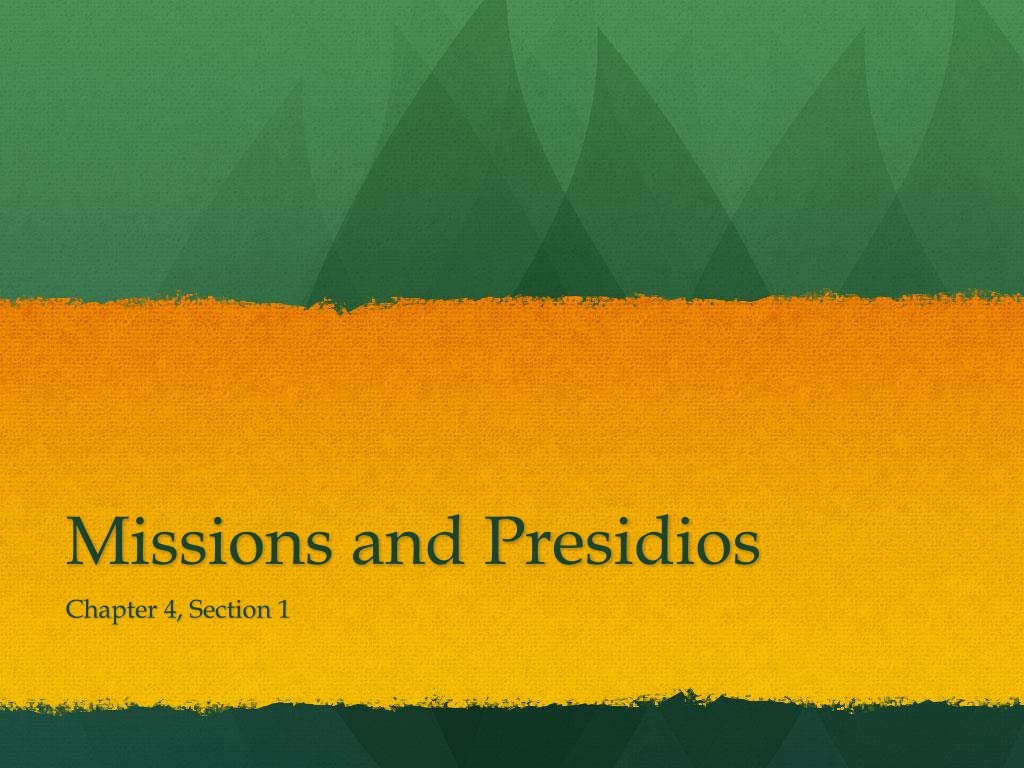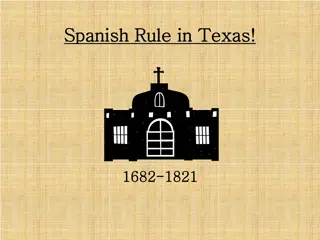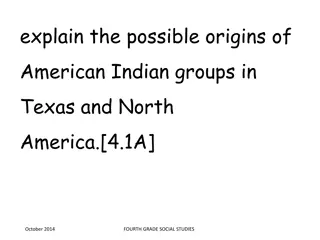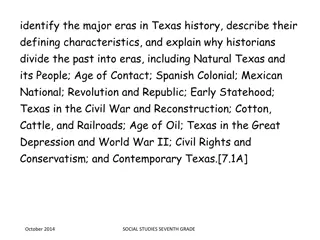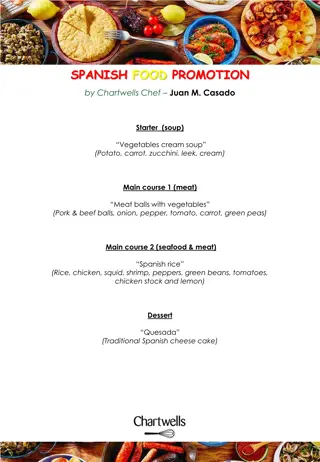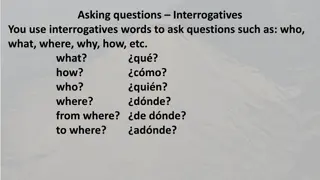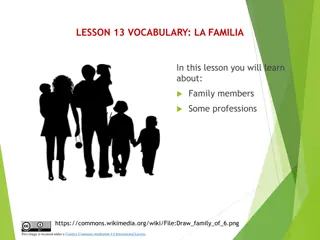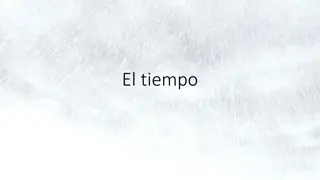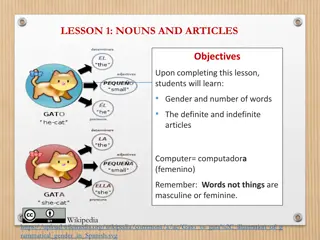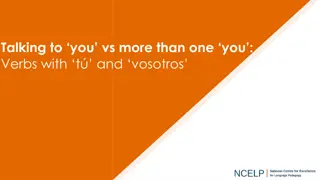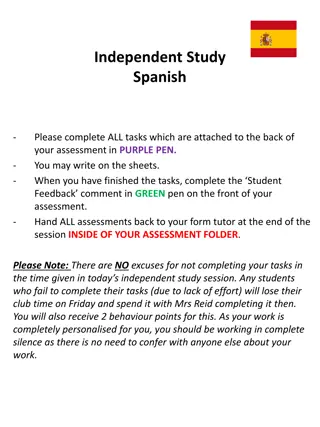Texas Mission-Presidio System: Spanish Control Efforts in Texas
Amid fears of losing control to the French in Texas, Spain implemented the mission-presidio system to establish settlements, convert Native Americans to Christianity, and make them loyal Spanish subjects. Friars played a key role in teaching Indigenous peoples about Christianity, Spanish language, and customs. However, some missions faced challenges such as diseases, crop failures, and conflicts leading to mission failures and Spanish retreats.
Download Presentation

Please find below an Image/Link to download the presentation.
The content on the website is provided AS IS for your information and personal use only. It may not be sold, licensed, or shared on other websites without obtaining consent from the author. Download presentation by click this link. If you encounter any issues during the download, it is possible that the publisher has removed the file from their server.
E N D
Presentation Transcript
Missions and Presidios Chapter 4, Section 1
Mission-Presidio System Because the French built a fort in Texas, Spain realized they were not in control of Texas, which provoked great fear among the Spanish. In order to gain control of Texas, the Spanish used the mission-presidio system to build the population of Texas. A mission is a settlement set up in Indian territory and were started by Friars. .
Mission Presidio System Friars are members of the clergy who belong to religious groups called orders. Friars invited Indians to live at the missions and Friars taught them about Christianity and the language and customs of Spain. They also taught them of Spanish farming methods
Goals The overall goal was to convert Native Americans to Christianity and also into loyal Spanish subjects. The system had worked well in Mexico and hoped to have the same success in Texas making it more Spanish
Presidios A presidio protected the mission. A presidio is a fort that offered safety from unfriendly Indians but it also helped to control the Native Americans inside the mission. The Spanish government paid the missionaries and the costs incurred to support the missions and presidios they were supposed to become completely self-supporting.
The First Missions In the 1680s the first mission in Texas was the mission of Corpus Christi de la Ysleta among the Tigua people (near El Paso) La Salle s arrival motivated Spain to move their efforts to the east. Tejas mission: Settled with the Hasinai people (a group of Caddo) whom the Spanish called the Tejas (because of their famous phrase tay yas ) in 1690. The called this mission San Francisco de los Tejas and it was located 20 miles northeast of present-day Crockett.
Mission Failure The Hasinai never fully took on the teachings of the friars and Spanish soldiers treated them harshly . Many Hasinai became sick with Spanish diseases because they had no resistance to them. A series of floods destroyed their crops and the Hasainai and they blamed the Spanish. .
Mission Failure The Hasinai people blamed the Spanish for this misfortune They began to attack the Spanish people The Spanish abandoned the missions and headed west. Before leaving the Friars buried the mission bells and destroyed the mission
Father Hidalgo In 1711, Spanish missionary Father Francisco Hidalgo wrote to the French to help Father Hidalgo with building a mission among the east Texas Caddo. They sent St. Denis. St. Denis who travelled through Texas and arrived at the mission of San Juan Bautista. He was arrested for being in Spanish lands. St. Denis convinced the Spanish to let him continue his missionary work and was freed.
Establishing Missions Working with Father Hidalgo, St. Denis established 6 missions and a presidio. One of these, Los Adaes, became the capital of the province of Texas, located near Natchitoches; so the Spanish can keep an eye on the French. Because Spain and France were at war in Europe in 1719, the war spread to the colonies.
The Chicken War French soldiers decided to raid Los Adaes and found little there besides chickens, which they took. This war became known as the Chicken War. After this war mission San Antonio de Valero was established because it was a halfway point between the Rio Grande and east Texas. This was built on the San Antonio River and the land was very desirable.
Other Missions Missions frequently faced raids from the Lipan Apaches, Companches, Wichitas, and Tonkawas. They frequently stole horses and cattle. Conflicts began to increase when the Comanches in the north continued to push south. In 1749 the Lipans and Spanish made peace. The Spanish planned to build a mission for the Lipans who had agreed to convert to Christianity if they were protected from the Comanches. The Spanish built Santa Cruz de San Saba Mission for the Lipans. They also built a presidio to protect the mission .
Santa Cruz de San Saba The Spanish did not know what the Lipans knew: the mission was located in Comanche territory . The Lipans were hoping to start a war between the Spanish and Comanches. The Lipan Apaches never really lived at the mission.
Santa Cruz de San Saba In 1758 about 2,000 Comanches, Wichitas, and Tonkawas came in search of the Lipans. They burned down the mission and killed most of the missionaries. The mission was never rebuilt, but the presidio remained for a number of years. The Spanish made one more attempt to build a mission among the Lipan on the upper Nueces River called Camp Wood. The Spanish could not keep the Lipan protected from attack and the mission failed. The Spanish stopped working with the Lipan.
Life in the Missions Chapter 4, Section 2
On the Missions Missionaries felt they should treat the Native Americans like they are children who needed someone to guide them. The Native Americans didn t feel this way. The Friars taught the Native Americans Christianity to convert them to Catholicism.
On the Mission The main source of labor on the missions was Native Americans. They planted and harvested crops and took care of the livestock in order to keep the settlement going. If a Native American did not work, they were punished. They were also punished for bad behavior.
Life in the Mission The Native Americans came to live on these missions because the friars gave them gifts, a steady supply of food, and protection from their enemies. The friars followed a rigid schedule: got up at dawn, went to daily religious meetings, said their prayers, and said the catechism (a set of questions and answers about Catholic beliefs). This schedule was used to convert the Native Americans to Catholicism.
Life on the Mission Farming year round was difficult for Native Americans to get used to. They were used to following animals for part of the year.
Sustaining the Mission In order to be successful, these missions needed to be self sufficient (support itself independently) Crops grown: Corn, beans, chili peppers, pimentos, watermelons, cantaloupes, pumpkins, and garden produce.
Sustaining the Mission Livestock raised: Sheep, goats, cattle, and other animals. Other things Native Americans made/did: Soap, bricks, cotton goods, became masons, seamstresses, and blacksmiths.
Mission Communities The missions created Spanish communities in Texas. In a few places, they became busy centers of trade. Towns grew up around the missions. Missionaries and soldiers also brought cattle and ranching to Texas. The Spanish appointed some of the mission Indians to be local chiefs.
Protection The Spanish expected the Native Americans to protect the forts without guns. Soldier s duties were to guard the livestock, carry messages, protect supply wagon trains, keep order in the mission, and protect the mission from Native American attacks. Some soldiers brought their families to the presidio to serve as models for the Indians and to attract other settlers to come live in town.
Unhealthy Conditions Living year round in close quarters proved to be unhealthy for many Native Americans because they could get sick and die. Epidemics (rapid spread of disease in a short time) were common.
Rejected! Many Native Americans rejected life in the missions. Others accepted the teachings of the friars and joined the Christian faith. Still, other Native Americans took up farming and ranching.
The Lipan Apaches The Lipan Apaches were accused of false friendliness because they asked for help against the Comanches originally, yet they never fully committed to mission life and sometimes continued to raid Spanish settlements and steal horses. The Comanches were hostile towards the Spanish too; they saw them as a threat. .
Problems Relations between officers and soldiers were often bad on these missions because officers often charged the soldiers more than the goods were worth and treated the soldiers badly, giving them poor supplies
Different Treatment Native Americans were treated differently by different people on these missions: Soldiers believed they had to use force in dealing with the Native Americans Friars tended to use more peaceful means.
The French Threat is Gone At this time, the French had lost the Seven Years War against Great Britain (also known as the French and Indian War) and ceded their land in Louisiana to Spain, removing the French threat in Texas. Still, as Marques de Rubi reports on behalf of Spain, that Spanish power was spread too thin in Texas and presidios could not protect Texas from the Native Americans. .
The French Threat is Gone Attacks were getting worse so Spain closed most of the missions. Only San Antonio and La Bahia were left open. Because of this, a unique blend of cultures was left in Texas; this new culture group was called Tejanos
The End Result Though the mission-presidio system failed, the Spanish did make two contributions to Texas lifestyles: Ranching and the language (naming of towns and rivers) Remaining settlers, led by Antonio Gil Ybaro left the remaining missions to resettle east Texas. The area they returned to was Nacogdoches. Only 3 Spanish settlements remained: San Antonio, La Bahia, and Nacogdoches.
